Table Of Contents
Introduction
What Is Meant By Laser Welding?
What Are The Different Types Of Laser Welding?
What Types Of Laser Beam Source Utilized In Laser Welding Machines?
Guidance To Choose The Right Laser Welding Machine
Which Configuration Should You Choose For The Laser Welding Machine?
What Parameters Should Be Checked?
Few Essential Tips To Maintain Laser Welding Machines
Conclusion
Key Takeaways
What Is Meant By Laser Welding?
Laser welding is a process of fusing different parts of the metal or thermoplastics by making use of a focused beam of laser light. The laser welding method is the most advanced method for welding and it is being utilized across several industries spanning from the healthcare sector and aerospace to jewelry making.
The laser welding process works by emitting a highly focused beam of laser light on the seam between the two metal parts to join them. This strong laser beam has the capability to melt the materials and make them into a joint. As a highly focused heat source is utilized in this process, laser welding in thin substances can be performed at really high speeds. When it comes to thicker substances, laser welding can yield narrow and deep welds.
What Are the Different Types of Laser Welding?
There are some common techniques of laser welding mentioned below:
1) Laser Seam Welding
The laser seam welding process is known for making continuous and long seams. It usually makes use of a filler rod to develop a filet at the joint area, employing pool control motions like those noticed in electrical and conventional thermal techniques.
2) Hybrid Laser Welding
This specific technique blends lasers and other welding methods such as TIG and MIG. Integrating different processes in this way provides you with the advantage of both machines.
3) Conduction Welding
This technique utilizes the downward power rating of any laser method. It tends to combine the melted parts of the metal through capillary action without using any filler. This type of method is reasonably conformed to welding specifically fitted edges of thin substances.
4) Laser Spot Welding
This method is best used for small, complex parts. The laser creates small, localized welds. These spot welds can make point joints between edges or melt through one part to merge with the part below.
5) Deep Penetration Welding
Deep penetration welding is favorable for welding materials that are thick. In this method, high laser power is utilized in order to heat a wide and deep area of the substance. Generally, the laser is directed to make a keyhole that penetrates via the substance. The keyhole is then sealed using a molten filler rod at its trailing rim as the laser advances along with the weld.
What Types Of Laser Beam Source Utilized In Laser Welding Machines?
The laser welding process makes use of three types of laser beam sources and they are fiber lasers, CO2 lasers, and Nd: YAG lasers. The selection of the laser beam source relies on the type of laser that you have decided on, which means continuous or pulsed. Let's have a look at all three of them:
1. Fiber Lasers
Fiber lasers are an efficient way to create high-quality spot welds because they are highly versatile. This type of laser can be utilized for a varied number of applications, from manufacturing and welding small components in different industries like engineering, medicine, and electronics.
2. CO2 Lasers
The CO2 laser is a type of gas laser. The power is driven via a gas-filled pipe/tube, generating light in this system. The most exciting feature of CO2 lasers is that the end parts of the pipes are mirrors, and one of them is completely reflective while the other one enables some light to penetrate. The gas mixture consists of carbon dioxide, hydrogen, helium, and nitrogen.
3. nd: YAG Lasers
Lastly, the nd: YAG lasers yield discrete pulses of the controlled energy that can be formed to develop the perfect weld. This type of laser is highly suitable for generating huge spot welds, deep spots, and seam welds.
Guidance To Choose The Right Laser Welding Machine
A laser welding machine can be run using two types of lasers: one is a pulsed laser and the second one is a continuous laser. The selection of one of the lasers relies on the thickness of one over the other one! Let's understand these two types of lasers:
Pulsed Laser
Using a pulsed laser, sheet metals, jewelry, razor blades, and many other substances can be welded. A pulsed laser helps in preventing the material from melting or deforming. A pulsed laser is highly suitable for metals that are light and thin.
Continuous Laser
When compared to pulsed lasers, this is more costly. It also helps in reducing operating expenses. Continuous laser is known to be more effective on refractory metals and is highly recommended for welding thick materials.
Which Configuration Should You Choose For The Laser Welding Machine?
Basically, 3 types of configurations are obtainable in laser welding machines, they are — Manual, Automatic, and Semi-Automatic. Thus, the selection of configuration completely depends on the level of your production, whether small-scale or large-scale, and your workstation arrangement.
Manual welding machines are highly skilled and compact in nature when compared to semi-automatic as well as automatic machines. This is considered to be highly suitable for small-scale production.
Next, the automatic welding machine does not require any human intervention and the existence of automatic loading & unloading stations reduces the downtime, which further enables revenues in productivity. The automatic welding machines are robotized, and they can automatically manage the placement of the workpiece that is under the laser source. These types of machines are suitable for large-scale production.
Lastly, semi-automatic laser welding machines need an operator to load the components manually in the welding fixture. These are bigger than manual welding machines and are fully furnished with turntables. They are highly suitable for medium as well as large-scale production.
Transform Your Welding Process - Explore Our Air-Cooled Handheld Laser Solutions!
What Parameters Should Be Checked?
You will be required to evaluate several parameters before utilizing your laser welding machine! A few of them are mentioned below:
Laser Pulses Frequency:
The laser pulse frequency consists of the capability of reflecting the number of pulses that can be generated in one second. In terms of constant laser energy, the higher the frequency, the lower the output of the laser! Therefore, you will have to make sure that the laser power is sufficient for melting the metal and the processing speed must be considered in order to specify the output laser frequency.
Power Density:
One of the most important parameters that must be considered in the laser welding machine is power density. If there is high power density, then the upper layer will be heated to boiling point which might result in a huge amount of vaporization. Therefore, the high power density is valuable for the removal of materials such as punching, carving, and cutting.
Laser Pulse Width:
The next crucial parameter of the laser welding machine is laser pulse width. It is not merely a crucial parameter that is distinct from material reduction and melting of material but is also considered the central parameter to specify the magnitude and expense of processing equipment.
Laser Pulse Waveform:
The laser pulse platform must be checked carefully, specifically when it comes to wafer welding. So, when the time comes to project a high-intensity team on the surface of the material, the metal surface will get reflected and also lose almost 70 to 90% laser energy, and the reflectivity will transform with the temperature of the surface. The metal reflectivity alters strongly at the time of a laser pulse.
Few Essential Tips To Maintain Laser Welding Machines
a) Regular Cleaning Of The Machines
Laser welding machines require regular cleaning and proper maintenance for their functioning. Remove any accumulated dust, debris, and other types of impurities that are produced at the time of the welding process. You must utilize appropriate cleaning agents and soft fabrics for cleaning purposes and also follow the guidelines that the manufacturer provides.
b) Regulate Welding Parameters
Precise calibration or regulation of welding parameters is critical for accomplishing consistent weld quality. Checking the given parameters regularly such as pulse frequency, laser, weld depth, and laser power. Erroneous parameters can lead to unstable quality of the welding or result in welding deformities. Welding parameters calibration makes sure that the laser welding machine stays reliable and efficient at the time of production.
c) Disciplined Maintenance
Just like the cleaning and lubrication process of the machine, routine maintenance is also required for the proper functioning of the laser welding machine. It is highly suggested to determine a maintenance schedule that involves substituting consumables, assessment of pipe and cable connections, and wiping or cleaning the water cooling system. Regularly maintaining the laser welding machine helps you to recognize the potential problems and failures of equipment, ensuring constant quality production.
d) Review The Laser Optics
One of the most important elements of a laser welding machine is the laser optics system. Aligning and examining the laser optic system is essential for its proper functioning. Any debris or variations in the laser optics system can have an impact on the stability and focus of the laser beam. Assuring immaculate and accurately aligned optical elements provides assistance in maintaining the efficiency of the laser welding machine.
Summing It up
In conclusion, the world of laser welding is an intriguing and rapidly evolving field with different types of laser welding methods and laser welding machines, each of them offering extraordinary advantages and applications in various fields and industries. Whether it's the precision of micro welding, the speed, accuracy, and versatility of fiber laser welding, or the depth and strength of electron beam welding, there's a laser welding method & machine suitable for a wide range of industries and materials.
Key Takeaways
Laser welding employs laser beams for the precise joining of two metal parts.
Types of laser welding machines encompass CO2, Nd: YAG, fiber, and diode lasers.
CO2 lasers are considered best for thick materials, and Nd: YAG lasers are ideal for thin materials.
Fiber lasers are adaptable and efficient, as they are highly suitable for numerous materials.
Diode lasers are compact and helpful for precision applications.
Laser welding can be utilized in pulsed or continuous wave modes.
Laser welding provides advantages such as high precision and minimal distortion.
Being knowledgeable about the welding speed and depth is important when choosing a laser welding machine.
The automation and integration options in laser welding machines enhance the efficiency of the manufacturing process.
Safety precautions, such as protective eyewear, are essential when using laser welding machines.
One needs to consider cost factors, including initial investment and operating expenses when choosing a laser welding machine.
Specialized laser welding machines are obtainable for specific industries and applications.






